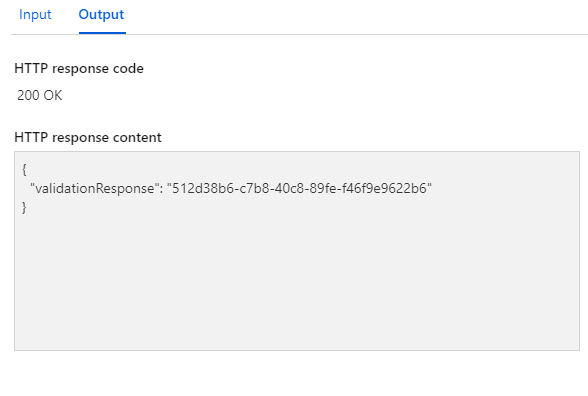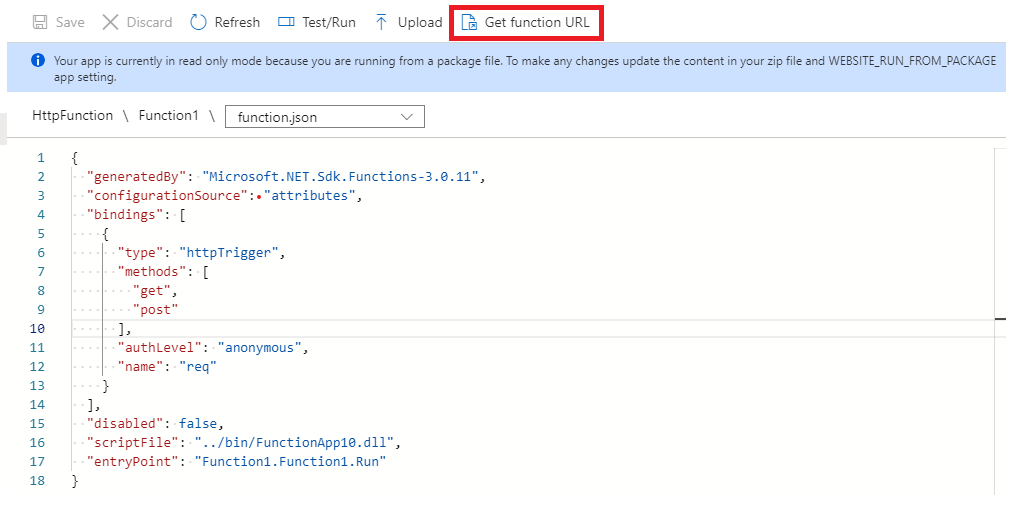你当前正在访问 Microsoft Azure Global Edition 技术文档网站。 如果需要访问由世纪互联运营的 Microsoft Azure 中国技术文档网站,请访问 https://docs.azure.cn。
将事件接收到 HTTP 终结点
本文介绍如何验证 HTTP 终结点以接收来自事件订阅的事件并随后接收和反序列化事件。 本文使用 Azure 函数进行演示,但无论应用程序托管在何处,这些概念都适用。
注意
建议在通过事件网格触发 Azure 函数时使用事件网格触发器。 它在事件网格和 Azure Functions 之间提供了更简单、更快速的集成。 但是注意,Azure Functions 的事件网格触发器不支持托管代码需要控制返回给事件网格的 HTTP 状态代码的场景。 鉴于此限制,例如,在 Azure Function 上运行的代码将无法返回 5XX 错误,以通过事件网格启动事件传送重试。
先决条件
需要包含 HTTP 触发函数的函数应用。
添加依赖项
若要使用 .NET 进行开发,请向 Azure.Messaging.EventGrid Nuget 包的函数添加依赖项。
可通过发布 SDKs 引用将 SDK 用于其他语言。 这些包中有用于本机事件类型(如 EventGridEvent、StorageBlobCreatedEventData 和 EventHubCaptureFileCreatedEventData)的模型。
终结点验证
首先需要处理 Microsoft.EventGrid.SubscriptionValidationEvent 事件。 每次有人订阅某个事件时,事件网格都会在数据有效负载中通过 validationCode 向终结点发送一个验证事件。 终结点必须回显到响应正文中才能证明此终结点有效且被你所拥有。 如果你使用的是事件网格触发器(而不是 Webhook 触发函数),系统会为你执行终结点验证。 如果使用第三方 API 服务(例如 Zapier 或 IFTTT),可能无法以编程方式回显验证码。 对于这些服务,可以使用订阅验证事件中发送的验证 URL 手动验证订阅。 在 validationUrl 属性中复制该 URL 并通过 REST 客户端或 Web 浏览器发送 GET 请求。
在 C# 中,ParseMany() 方法用于将包含一个或多个事件的 BinaryData 实例反序列化为 EventGridEvent 数组。 如果你提前知道只反序列化单个事件,则可以改用 Parse 方法。
若要以编程方式回显验证码,请运行下面的代码。
using System.Threading.Tasks;
using Microsoft.AspNetCore.Mvc;
using Microsoft.Azure.WebJobs;
using Microsoft.Azure.WebJobs.Extensions.Http;
using Microsoft.AspNetCore.Http;
using Microsoft.Extensions.Logging;
using System;
using Azure.Messaging.EventGrid;
using Azure.Messaging.EventGrid.SystemEvents;
namespace Function1
{
public static class Function1
{
[FunctionName("Function1")]
public static async Task<IActionResult> Run(
[HttpTrigger(AuthorizationLevel.Anonymous, "get", "post", Route = null)] HttpRequest req,
ILogger log)
{
log.LogInformation("C# HTTP trigger function processed a request.");
string response = string.Empty;
BinaryData events = await BinaryData.FromStreamAsync(req.Body);
log.LogInformation($"Received events: {events}");
EventGridEvent[] eventGridEvents = EventGridEvent.ParseMany(events);
foreach (EventGridEvent eventGridEvent in eventGridEvents)
{
// Handle system events
if (eventGridEvent.TryGetSystemEventData(out object eventData))
{
// Handle the subscription validation event
if (eventData is SubscriptionValidationEventData subscriptionValidationEventData)
{
log.LogInformation($"Got SubscriptionValidation event data, validation code: {subscriptionValidationEventData.ValidationCode}, topic: {eventGridEvent.Topic}");
// Do any additional validation (as required) and then return back the below response
var responseData = new
{
ValidationResponse = subscriptionValidationEventData.ValidationCode
};
return new OkObjectResult(responseData);
}
}
}
return new OkObjectResult(response);
}
}
}
module.exports = function (context, req) {
context.log('JavaScript HTTP trigger function begun');
var validationEventType = "Microsoft.EventGrid.SubscriptionValidationEvent";
for (var events in req.body) {
var body = req.body[events];
// Deserialize the event data into the appropriate type based on event type
if (body.data && body.eventType == validationEventType) {
context.log("Got SubscriptionValidation event data, validation code: " + body.data.validationCode + " topic: " + body.topic);
// Do any additional validation (as required) and then return back the below response
var code = body.data.validationCode;
context.res = { status: 200, body: { "ValidationResponse": code } };
}
}
context.done();
};
测试验证响应
通过将样本事件粘贴到函数的测试字段,测试验证响应函数:
[{
"id": "2d1781af-3a4c-4d7c-bd0c-e34b19da4e66",
"topic": "/subscriptions/xxxxxxxx-xxxx-xxxx-xxxx-xxxxxxxxxxxx",
"subject": "",
"data": {
"validationCode": "512d38b6-c7b8-40c8-89fe-f46f9e9622b6"
},
"eventType": "Microsoft.EventGrid.SubscriptionValidationEvent",
"eventTime": "2018-01-25T22:12:19.4556811Z",
"metadataVersion": "1",
"dataVersion": "1"
}]
选择“运行”时,输出应为“200 正常”且正文中应显示 {"validationResponse":"512d38b6-c7b8-40c8-89fe-f46f9e9622b6"}:


处理 Blob 存储事件
现在,让我们扩展函数来处理 Microsoft.Storage.BlobCreated 系统事件:
using System.Threading.Tasks;
using Microsoft.AspNetCore.Mvc;
using Microsoft.Azure.WebJobs;
using Microsoft.Azure.WebJobs.Extensions.Http;
using Microsoft.AspNetCore.Http;
using Microsoft.Extensions.Logging;
using System;
using Azure.Messaging.EventGrid;
using Azure.Messaging.EventGrid.SystemEvents;
namespace Function1
{
public static class Function1
{
[FunctionName("Function1")]
public static async Task<IActionResult> Run(
[HttpTrigger(AuthorizationLevel.Anonymous, "get", "post", Route = null)] HttpRequest req,
ILogger log)
{
log.LogInformation("C# HTTP trigger function processed a request.");
string response = string.Empty;
BinaryData events = await BinaryData.FromStreamAsync(req.Body);
log.LogInformation($"Received events: {events}");
EventGridEvent[] eventGridEvents = EventGridEvent.ParseMany(events);
foreach (EventGridEvent eventGridEvent in eventGridEvents)
{
// Handle system events
if (eventGridEvent.TryGetSystemEventData(out object eventData))
{
// Handle the subscription validation event
if (eventData is SubscriptionValidationEventData subscriptionValidationEventData)
{
log.LogInformation($"Got SubscriptionValidation event data, validation code: {subscriptionValidationEventData.ValidationCode}, topic: {eventGridEvent.Topic}");
// Do any additional validation (as required) and then return back the below response
var responseData = new
{
ValidationResponse = subscriptionValidationEventData.ValidationCode
};
return new OkObjectResult(responseData);
}
// Handle the storage blob created event
else if (eventData is StorageBlobCreatedEventData storageBlobCreatedEventData)
{
log.LogInformation($"Got BlobCreated event data, blob URI {storageBlobCreatedEventData.Url}");
}
}
}
return new OkObjectResult(response);
}
}
}
module.exports = function (context, req) {
context.log('JavaScript HTTP trigger function begun');
var validationEventType = "Microsoft.EventGrid.SubscriptionValidationEvent";
var storageBlobCreatedEvent = "Microsoft.Storage.BlobCreated";
for (var events in req.body) {
var body = req.body[events];
// Deserialize the event data into the appropriate type based on event type
if (body.data && body.eventType == validationEventType) {
context.log("Got SubscriptionValidation event data, validation code: " + body.data.validationCode + " topic: " + body.topic);
// Do any additional validation (as required) and then return back the below response
var code = body.data.validationCode;
context.res = { status: 200, body: { "ValidationResponse": code } };
}
else if (body.data && body.eventType == storageBlobCreatedEvent) {
var blobCreatedEventData = body.data;
context.log("Relaying received blob created event payload:" + JSON.stringify(blobCreatedEventData));
}
}
context.done();
};
测试能否处理“已处理 Blob”事件
通过将 Blob 存储事件放到测试字段中并运行以下项来测试函数的新功能:
[{
"topic": "/subscriptions/{subscription-id}/resourceGroups/Storage/providers/Microsoft.Storage/storageAccounts/xstoretestaccount",
"subject": "/blobServices/default/containers/testcontainer/blobs/testfile.txt",
"eventType": "Microsoft.Storage.BlobCreated",
"eventTime": "2017-06-26T18:41:00.9584103Z",
"id": "aaaa0a0a-bb1b-cc2c-dd3d-eeeeee4e4e4e",
"data": {
"api": "PutBlockList",
"clientRequestId": "bbbb1b1b-cc2c-dd3d-ee4e-ffffff5f5f5f",
"requestId": "cccc2c2c-dd3d-ee4e-ff5f-aaaaaa6a6a6a",
"eTag": "0x8D4BCC2E4835CD0",
"contentType": "text/plain",
"contentLength": 524288,
"blobType": "BlockBlob",
"url": "https://example.blob.core.windows.net/testcontainer/testfile.txt",
"sequencer": "00000000000004420000000000028963",
"storageDiagnostics": {
"batchId": "dddd3d3d-ee4e-ff5f-aa6a-bbbbbb7b7b7b"
}
},
"dataVersion": "",
"metadataVersion": "1"
}]
函数日志中应该会显示 Blob URL 输出:
2022-11-14T22:40:45.978 [Information] Executing 'Function1' (Reason='This function was programmatically called via the host APIs.', Id=8429137d-9245-438c-8206-f9e85ef5dd61)
2022-11-14T22:40:46.012 [Information] C# HTTP trigger function processed a request.
2022-11-14T22:40:46.017 [Information] Received events: [{"topic": "/subscriptions/{subscription-id}/resourceGroups/Storage/providers/Microsoft.Storage/storageAccounts/xstoretestaccount","subject": "/blobServices/default/containers/testcontainer/blobs/testfile.txt","eventType": "Microsoft.Storage.BlobCreated","eventTime": "2017-06-26T18:41:00.9584103Z","id": "aaaa0a0a-bb1b-cc2c-dd3d-eeeeee4e4e4e","data": {"api": "PutBlockList","clientRequestId": "bbbb1b1b-cc2c-dd3d-ee4e-ffffff5f5f5f","requestId": "cccc2c2c-dd3d-ee4e-ff5f-aaaaaa6a6a6a","eTag": "0x8D4BCC2E4835CD0","contentType": "text/plain","contentLength": 524288,"blobType": "BlockBlob","url": "https://example.blob.core.windows.net/testcontainer/testfile.txt","sequencer": "00000000000004420000000000028963","storageDiagnostics": {"batchId": "dddd3d3d-ee4e-ff5f-aa6a-bbbbbb7b7b7b"}},"dataVersion": "","metadataVersion": "1"}]
2022-11-14T22:40:46.335 [Information] Got BlobCreated event data, blob URI https://example.blob.core.windows.net/testcontainer/testfile.txt
2022-11-14T22:40:46.346 [Information] Executed 'Function1' (Succeeded, Id=8429137d-9245-438c-8206-f9e85ef5dd61, Duration=387ms)
还可以通过以下方式进行测试:创建一个 Blob 存储帐户或通用版 V2 存储帐户,添加事件订阅,然后将终结点设置为函数 URL:

处理自定义事件
最后,再次扩展函数,使其还能够处理自定义事件。
添加对事件 Contoso.Items.ItemReceived 的检查。 最终代码应如下所示:
using System.Threading.Tasks;
using Microsoft.AspNetCore.Mvc;
using Microsoft.Azure.WebJobs;
using Microsoft.Azure.WebJobs.Extensions.Http;
using Microsoft.AspNetCore.Http;
using Microsoft.Extensions.Logging;
using System;
using Azure.Messaging.EventGrid;
using Azure.Messaging.EventGrid.SystemEvents;
namespace Function1
{
public static class Function1
{
[FunctionName("Function1")]
public static async Task<IActionResult> Run(
[HttpTrigger(AuthorizationLevel.Anonymous, "get", "post", Route = null)] HttpRequest req,
ILogger log)
{
log.LogInformation("C# HTTP trigger function processed a request.");
string response = string.Empty;
BinaryData events = await BinaryData.FromStreamAsync(req.Body);
log.LogInformation($"Received events: {events}");
EventGridEvent[] eventGridEvents = EventGridEvent.ParseMany(events);
foreach (EventGridEvent eventGridEvent in eventGridEvents)
{
// Handle system events
if (eventGridEvent.TryGetSystemEventData(out object eventData))
{
// Handle the subscription validation event
if (eventData is SubscriptionValidationEventData subscriptionValidationEventData)
{
log.LogInformation($"Got SubscriptionValidation event data, validation code: {subscriptionValidationEventData.ValidationCode}, topic: {eventGridEvent.Topic}");
// Do any additional validation (as required) and then return back the below response
var responseData = new
{
ValidationResponse = subscriptionValidationEventData.ValidationCode
};
return new OkObjectResult(responseData);
}
// Handle the storage blob created event
else if (eventData is StorageBlobCreatedEventData storageBlobCreatedEventData)
{
log.LogInformation($"Got BlobCreated event data, blob URI {storageBlobCreatedEventData.Url}");
}
}
// Handle the custom contoso event
else if (eventGridEvent.EventType == "Contoso.Items.ItemReceived")
{
var contosoEventData = eventGridEvent.Data.ToObjectFromJson<ContosoItemReceivedEventData>();
log.LogInformation($"Got ContosoItemReceived event data, item SKU {contosoEventData.ItemSku}");
}
}
return new OkObjectResult(response);
}
}
}
module.exports = function (context, req) {
context.log('JavaScript HTTP trigger function begun');
var validationEventType = "Microsoft.EventGrid.SubscriptionValidationEvent";
var storageBlobCreatedEvent = "Microsoft.Storage.BlobCreated";
var customEventType = "Contoso.Items.ItemReceived";
for (var events in req.body) {
var body = req.body[events];
// Deserialize the event data into the appropriate type based on event type
if (body.data && body.eventType == validationEventType) {
context.log("Got SubscriptionValidation event data, validation code: " + body.data.validationCode + " topic: " + body.topic);
// Do any additional validation (as required) and then return back the below response
var code = body.data.validationCode;
context.res = { status: 200, body: { "ValidationResponse": code } };
}
else if (body.data && body.eventType == storageBlobCreatedEvent) {
var blobCreatedEventData = body.data;
context.log("Relaying received blob created event payload:" + JSON.stringify(blobCreatedEventData));
}
else if (body.data && body.eventType == customEventType) {
var payload = body.data;
context.log("Relaying received custom payload:" + JSON.stringify(payload));
}
}
context.done();
};
测试能否处理自定义事件
最后,测试函数现在能否处理自定义事件类型:
[{
"subject": "Contoso/foo/bar/items",
"eventType": "Contoso.Items.ItemReceived",
"eventTime": "2017-08-16T01:57:26.005121Z",
"id": "602a88ef-0001-00e6-1233-1646070610ea",
"data": {
"itemSku": "Standard"
},
"dataVersion": "",
"metadataVersion": "1"
}]
还可实时测试此功能,方式是在门户中通过 CURL 发送自定义事件,或者使用任何可通过 POST 发送到终结点的服务或应用程序发布到自定义主题。 使用终结点集作为函数 URL,创建自定义主题和事件订阅。
消息标头
以下是在消息标头中接收的属性:
| 属性名称 | 说明 |
|---|---|
| aeg-subscription-name | 事件订阅的名称。 |
| aeg-delivery-count | 针对该事件进行尝试的次数。 |
| aeg-event-type | 事件的类型。 可以为下列值之一:
|
| aeg-metadata-version | 事件的元数据版本。 对于“事件网格事件架构”,此属性表示元数据版本;对于“云事件架构”,此属性表示规范版本。 |
| aeg-data-version | 事件的数据版本。 对于“事件网格事件架构”,此属性表示数据版本;对于“云事件架构”,此属性不适用。 |
| aeg-output-event-id | 事件网格事件的 ID。 |
后续步骤
- 浏览 Azure 事件网格管理和发布 SDK
- 了解如何发布到自定义主题